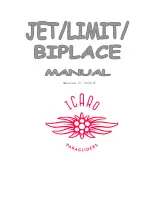
5
Attention!
If the brake lines are pulled too far or too fast, there is a risk of a spin/stall!
A one-sided stall (negative turn) clearly announces itself: the wing starts to lose inner pressure and shape during the curve. In this
phase, the inside brake is to be released immediately!
Landing
The MAESTRO light is easy to land. In the final approach against the wind flare the wing at an appropriate height. Normally about
1m above ground level, the angle of attack should be increased by more and more braking. When the minimum speed is reached,
the brakes are pulled to the max, the wing and this technique allows a so touch down.
In strong headwinds you brake very little. Only when the pilot is safely on the ground, he stalls the wing with caution (possibly
with the rear risers).
Attention!
Landings with steep turns in the final approach are absolutely to be avoided (dangers resulting from pendulums)!
A complete stall can result in a very hard impact of the pilot even at just two meters altitude. Therefore, the brakes should be fully
pulled only just before touchdown.
Rapid descents
Attention!
All rapid descent maneuvers should be practiced in calm air and with sufficient safety height to safely use them in emergency
situations with turbulent air.
For all extreme flying maneuvers and rapid descents:
- first practice under the guidance of a teacher as part of a safety training.
- before initiating maneuvers, the pilot ascertains that the airspace below/around him is clear.
- during the maneuver, the pilot must constantly control the altitude above ground.
Big ears
Applying big ears is extremely effective and easy to perform with the MAESTRO light. Initiate the outer A-risers (red/orange) by
grabbing at the top of the shackle on both sides, and pulling symmetrically down. The brake handles remain in the hand (without
additional wrapping). As long as the risers are held down, the wingtips remain folded and the sink value increases.
If wingtips do not fold completely at the beginning, it is advisable to repeat the initiation, pulling the A-straps faster and / or
grasping the outer A-riser above the shackle. The more impulsive pull and the larger amount of pull on the outer A-riser facilitates
the folding of the wingtips.
It is recommended to accelerate the wing additionally to increase the sink rate and the forward speed. It also compensates for the
increase in angle of attack caused by the added resistance of the applied ears.
To release the maneuver, it is sufficient to release the outer A risers back up again, whereupon the MAESTRO light independently
recovers the wingtips.
If the ears do not fill completely by themselves, the filling can be achieved by a short brake input. It is important to ensure that it is
only a short and limited brake input, or that the brakes are released immediately.
Bunny Ears
The modern technique of pulling the outer C lines to initiate “bunny-ears” is not recommended for the MAESTRO light. In
development we have reduced line consumption and line drag by reducing the number of lines. As a result The area held by the
outer C line is larger and pulling on the line affects a large area of the sail which can put the wing into a stalled configuration.
B-Stall
The B-stall is initiated by symmetrical pulling down (about 20cm) of the B-risers. The introduction forces are relatively high, but
decrease with increasing amount of pulling. For maximum effect, it is recommended to grab the risers at the top of the shackles.
The wing immediately loses its forward speed when the B risers are pulled down and enters a stable stall. The pilot shi s slightly
in front of the wing. The further the B-risers are pulled down, the larger the sink rates (up to 9m / s).
Содержание Maestro Light
Страница 1: ...1 Manual Version 1 04 of 29 09 2022...
Страница 13: ...13 Overview wing...
Страница 14: ...14 Lineplan...
































